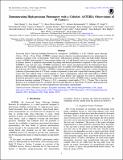Demonstrating High-precision Photometry with a CubeSat: ASTERIA Observations of 55 Cancri e
Author(s)
Knapp, Mary; Seager, Sara; Demory, Brice-Olivier; Krishnamurthy, Akshata; Smith, Matthew W; Pong, Christopher M; Bailey, Vanessa P; Donner, Amanda; Pasquale, Peter Di; Campuzano, Brian; Smith, Colin; Luu, Jason; Babuscia, Alessandra; Loveland, Jessica; Colley, Cody; Gedenk, Tobias; Kulkarni, Tejas; Hughes, Kyle; White, Mary; Krajewski, Joel; Fesq, Lorraine; Bocchino, Robert L, Jr.; ... Show more Show less
DownloadPublished version (1.917Mb)
Publisher Policy
Publisher Policy
Article is made available in accordance with the publisher's policy and may be subject to US copyright law. Please refer to the publisher's site for terms of use.
Terms of use
Metadata
Show full item recordAbstract
© 2020. The American Astronomical Society. All rights reserved Arcsecond Space Telescope Enabling Research In Astrophysics (ASTERIA) is a 6U CubeSat space telescope (10 cm 20 cm 30 cm, 10 kg). ASTERIA's primary mission objective was demonstrating two key technologies for reducing systematic noise in photometric observations: high-precision pointing control and high-stability thermal control. ASTERIA demonstrated 0.″5 rms pointing stability and 10 mK thermal control of its camera payload during its primary mission, a significant improvement in pointing and thermal performance compared to other spacecraft in ASTERIA's size and mass class. ASTERIA launched in 2017 August and deployed from the International Space Station in 2017 November. During the prime mission (2017 November-2018 February) and the first extended mission that followed (2018 March-2018 May), ASTERIA conducted opportunistic science observations, which included the collection of photometric data on 55 Cancri, a nearby exoplanetary system with a super-Earth transiting planet. The 55 Cancri data were reduced using a custom pipeline to correct complementary metal-oxide semiconductor (CMOS) detector column-dependent gain variations. A Markov Chain Monte Carlo approach was used to simultaneously detrend the photometry using a simple baseline model and fit a transit model. ASTERIA made a marginal detection of the known transiting exoplanet 55 Cancri e (∼2 R⊕), measuring a transit depth of 374 170 ppm. This is the first detection of an exoplanet transit by a CubeSat. The successful detection of super-Earth 55 Cancri e demonstrates that small, inexpensive spacecraft can deliver high-precision photometric measurements.
Date issued
2020Department
Haystack Observatory; Massachusetts Institute of Technology. Department of Physics; MIT Kavli Institute for Astrophysics and Space Research; Massachusetts Institute of Technology. Department of Earth, Atmospheric, and Planetary Sciences; Massachusetts Institute of Technology. Department of Aeronautics and AstronauticsJournal
Astronomical Journal
Publisher
American Astronomical Society